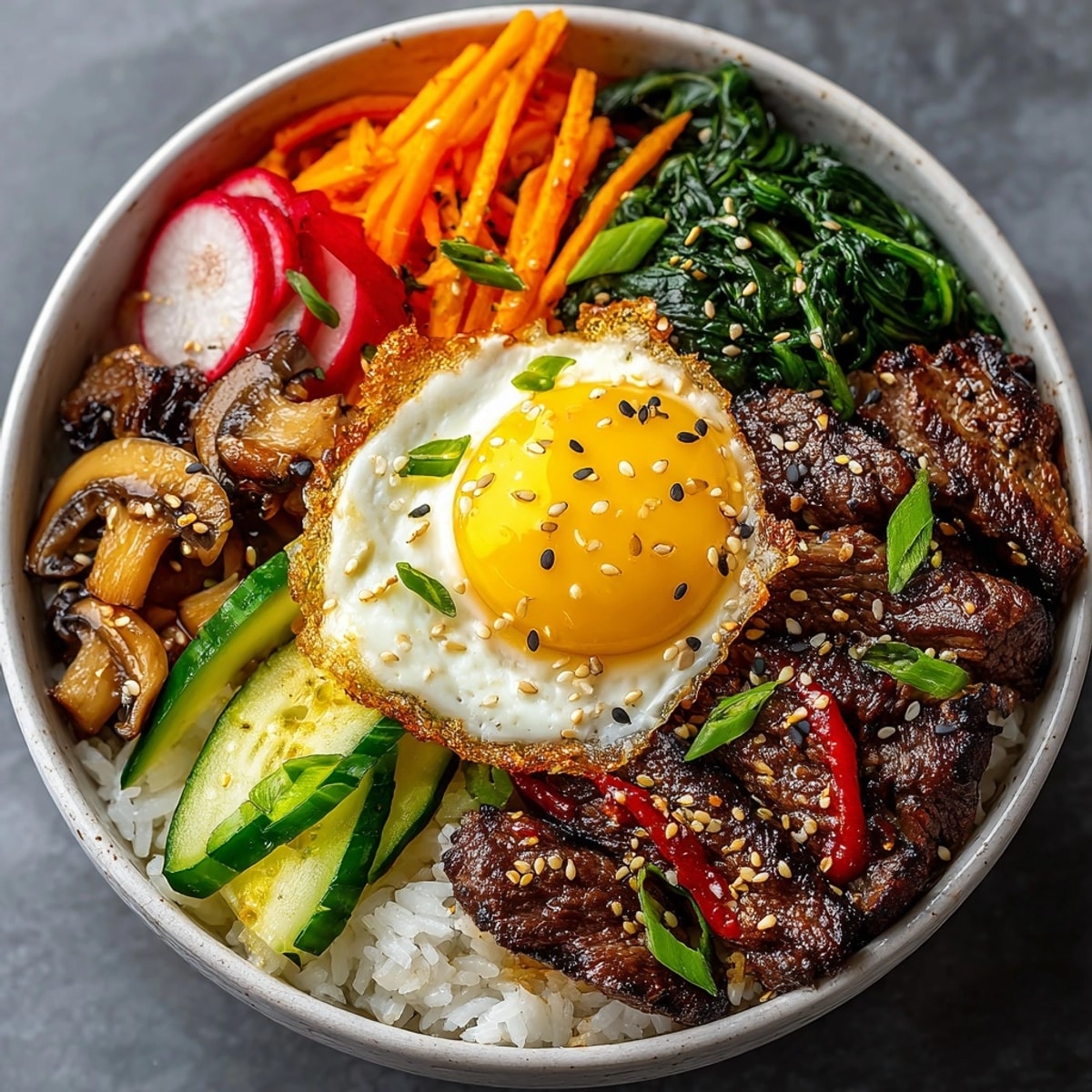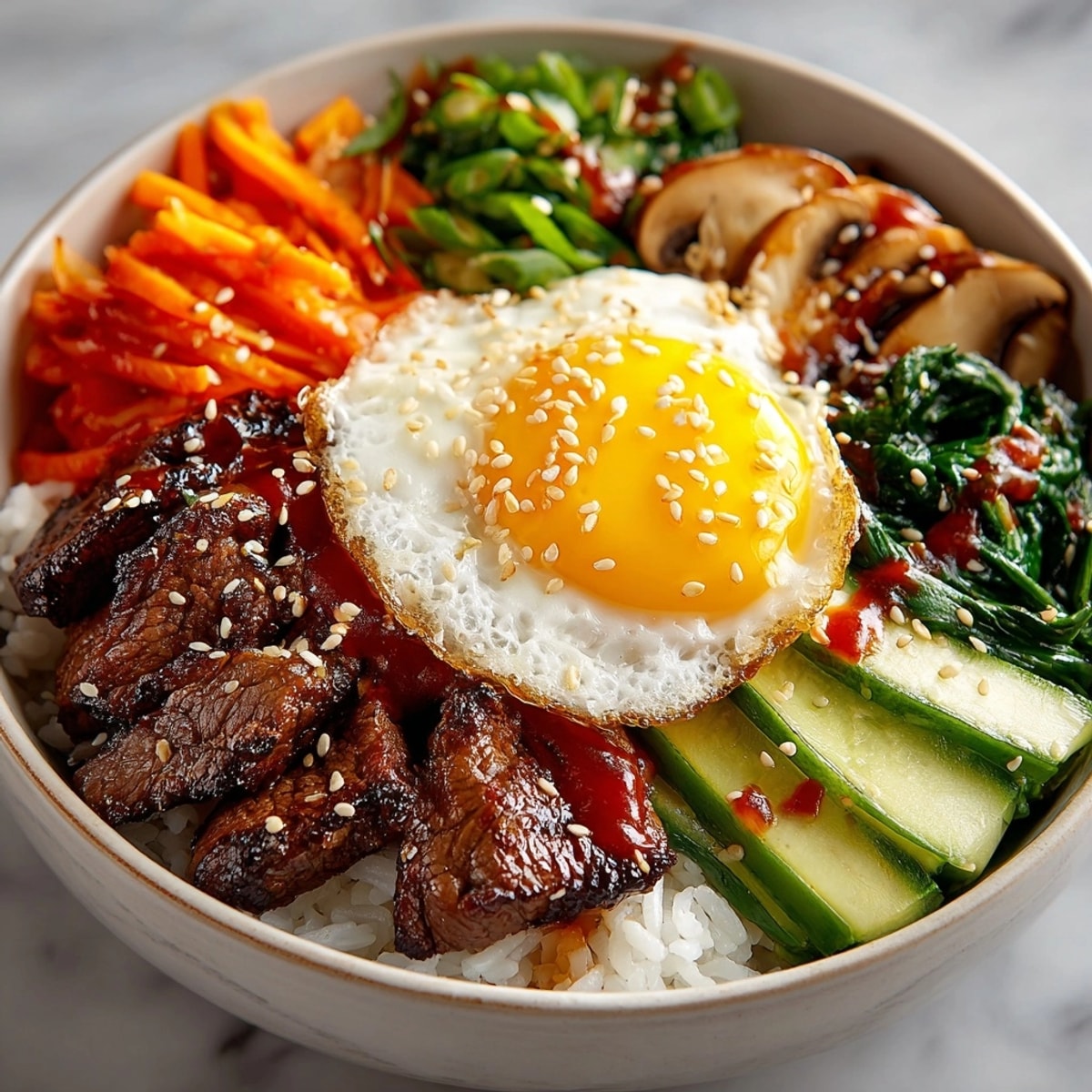 Save
Save Craving a satisfying weeknight meal that hits every flavor note These Korean Beef Bibimbap Bowls are my answer to bold taste in under an hour It is a go-to for customizable dinners when I want everyone at the table happy plus it makes leftovers you will actually want for lunch
I first threw this together after a long week needing comfort and color on my plate My family immediately requested it for our next get-together
Ingredients
- Short grain white rice: gives Bibimbap its signature stickiness choose medium-short grain or sushi rice for best results
- Ground beef: the star protein pick 80 or 85 percent lean for super flavorful bits
- Soy sauce: brings savory depth look for a naturally brewed bottle
- Gochujang: that magical Korean red chili paste adds spicy sweetness
- Sesame oil: for classic toasted aroma pick the darkest toasted oil you can find
- Carrot: cut into matchsticks for crunch and color choose firm bright carrots
- Zucchini: offers freshness and a soft bite opt for smaller zucchini to avoid excess water
- Spinach: brings a mild green balance choose fresh baby spinach for easy prep
- Bean sprouts: essential for classic crunch look for crisp and pale sprouts
- Eggs: sunny side up or over easy give you a rich silky topping use the freshest eggs available
- Kimchi: brings tangy spicy contrast grab a traditional napa cabbage kimchi if possible
- Green onion: sliced for a final fresh bite always add right before serving
- Toasted sesame seeds: finish everything with delicate crunch store seeds in the freezer for freshness
Instructions
- Rinse and cook the rice:
- Rinse rice under cold water until water runs clear This prevents it from being gummy Add rice and water to a saucepan bring to a boil then reduce heat and cover Simmer for about 15 minutes and let rest off heat for 10 minutes
- Prepare vegetables:
- While rice cooks julienne the carrot and zucchini Plunge spinach into boiling water for twenty seconds then immediately cool in ice water This keeps the green color and tender texture
- Stir fry the beef:
- Heat a large skillet over medium-high Add ground beef and break apart as it browns Pour off excess fat Then stir in soy sauce gochujang sugar garlic ginger and half of the sesame oil Cook until sauce is glossy and coats the meat about five minutes
- Sauté vegetables:
- Using the pan residual oil quickly stir fry carrots and zucchini separately each for about two minutes with a pinch of salt until just wilted Remove to separate bowls to avoid mixing flavors
- Sauté bean sprouts:
- Heat a splash of sesame oil in the pan Add washed sprouts and cook for one minute until just translucent Keep them crisp
- Fry eggs:
- Wipe out your pan and swirl in a little oil Fry eggs one per bowl sunny side up or over easy The yolk should be runny to blend with your finished bowl
- Build the bowl:
- Scoop steaming rice into each bowl Arrange small piles of beef carrots zucchini spinach bean sprouts and kimchi artfully on top Lay a fried egg in the middle Sprinkle generously with green onion and toasted sesame seeds Drizzle with remaining sesame oil and a dash more gochujang if desired
 Save
Save My favorite is always the runny egg mixing with the sauce and rice Nothing brings me back to weekend lunch with my sister faster than this dish and we love making extra toppings so everyone gets exactly what they want
Storage Tips
Bibimbap toppings keep well in airtight containers for three days Keep rice refrigerated separately for best texture Reheat the beef and veggies in a microwave or skillet then add a freshly fried egg to bring it all back to life
Ingredient Substitutions
Swap ground turkey or tofu for beef to make it lighter or vegetarian No gochujang Use a little sriracha or chili garlic paste with a hint of honey If you do not have bean sprouts skip them or add thinly sliced radish for crunch
Serving Suggestions
Serve family style so everyone can pick their own toppings and arrange their bowls Add extra kimchi on the side and a bowl of miso soup or seaweed salad for a bigger Korean inspired spread
Cultural Context
Bibimbap is a beloved Korean dish whose name means mixed rice It is traditionally topped with seasonal vegetables and gochujang and often served in a sizzling stone bowl When you stir everything together the flavors and textures become pure comfort food
Seasonal Adaptations
Use sautéed mushrooms or blanched asparagus in spring Swap in shredded cabbage or pickled radish in winter Top with fresh cherry tomatoes and thin pepper strips in summer Sometimes my favorite way to adapt Bibimbap is to use whatever vegetable is overflowing from my farmers market basket That is how I discovered spinach tastes even better when flash-blanched
Success Stories
A friend made these bowls for a dinner party and each guest created their own plate The meal turned into a fun build-your-own adventure and sparked lots of requests for the recipe
Freezer Meal Conversion
Divide cooked beef and sautéed veggies into single serve freezer bags Lay flat for fast defrosting Store rice separately and freeze in portions Reheat gently in the microwave and add a freshly fried egg when serving
 Save
Save I learned the value of prepping all your toppings in advance The final dish comes together like magic when everything is ready to go
Recipe Guide
- → Which vegetables pair well in bibimbap bowls?
Traditional options include carrots, spinach, bean sprouts, zucchini, and mushrooms. Feel free to add your favorites.
- → How is the beef typically seasoned?
Thinly sliced beef is marinated with soy sauce, garlic, sesame oil, sugar, and sometimes gochujang for depth and spice.
- → Can these bowls be made vegetarian?
Yes, swap the beef for tofu or extra veggies. The flavorful sauce and toppings make them equally enjoyable.
- → Is gochujang necessary for authentic flavor?
Gochujang adds signature heat and richness. If unavailable, try chili paste or a mild sriracha blend as a substitute.
- → What is the best way to serve bibimbap bowls?
Arrange toppings neatly over rice, drizzle with sauce, then mix thoroughly before eating to blend flavors and textures.